- Author
- Haynes, Fred
- Subjects
- Naval Aviation
- Tags
-
- RAN Ships
- HMAS Australia II
- Publication
- June 2002 edition of the Naval Historical Review (all rights reserved)
Navies ignore threat of aircraft
The emergence of airpower as a formidable weapon at the end of WW I was to a large extent ignored by Allied Navies as a threat. The bomber was seen as a weapon to be used against enemy land forces and manufacturing industries and not the Capital ship at sea. However in 1921 American General “Billy” Mitchell showed the potential of airpower against ships at sea when in 1921 his bombers sank the surrendered German battleship Ostfriesland as a demonstration.
British and American navies were still unconvinced by this demonstration and pointed out that the targets were undefended, not underway, or capable of manoeuvring. Mitchell pointed out that even more efficient and effective tactics for attack would be used in wartime. The Royal Navy and American Navy still remained reluctant to admit that bombers could in any circumstances sink heavy warships. A decade later further improvements in aircraft capabilities, particularly in carrier based torpedo bombers, began to influence thinking on anti-aircraft defences for warships.
Anti-aircraft gunnery
In 1933 in response to the need for both the Royal Navy, and the Army, to improve their standards in anti-aircraft gun accuracy, the Air Ministry issued Specification 18/33. This called for a radio controlled target aircraft for operation from land or sea. The De Havilland company submitted a revision of their basic Tiger Moth design which was a combination of the wooden fuselage frame of the earlier Moth Major with the normal components of a Tiger Moth, fitted with Short Bros floats for naval use and radio control equipment under hinged decking in the rear cockpit. The aircraft could still be flown manually from the front cockpit.
Experimental work on radio control at the Royal Aircraft Establishment (RAE) Farmborough enabled the aircraft to be flown remotely while being shot at. If efforts to hit the target were unsuccessful it was able to land alongside the ship and be hoisted aboard for further use.
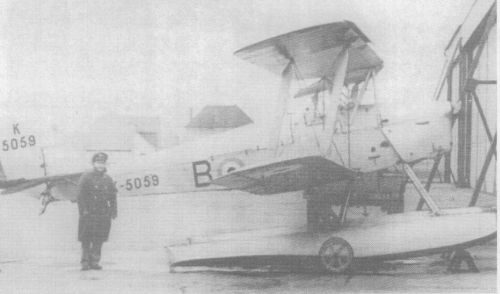
Note wheels fitted to floats.
The D.H. “Queen Bee” Wireless-controlled Target Aeroplane (130 b.p. D.H. “Gipsy-Major” engine).
The prototype DH.82B Queen Bee, as it was named, first flew at Hatfield on 5 January 1935. Later that year a demonstration flight showed all the manoeuvres from take-off to touchdown being completed without a pilot onboard. Success of the prototype led to production orders to revised Specification 20/35.
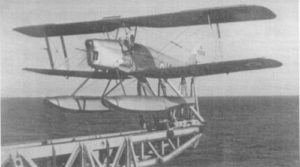
Anti-Aircraft Cooperation Units (AACU) were established at home and overseas bases including Malta and Singapore to operate the aircraft.
On August 26th 1935, while on exchange service with HMS Sussex of the Mediterranean Fleet , HMAS Australia was fitted in Portsmouth Dockyard, between the after funnel and X-turret, with a light 50-Knot rotating Catapult Type S IIL. Deadload trials of the catapult were completed on 9 September in readiness for embarkation of the new Seagull V.
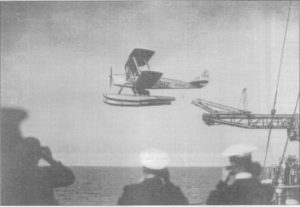
While serving in the 1st Cruiser Squadrons Mediterranean Fleet, in Alexandria Egypt, Australia was called upon to operate the Queen Bee during the conduct of anti-aircraft gunnery exercises During the flights from Australia the front cockpit was fitted with a dummy pilot that gave the appearance of a piloted aircraft. He was christened “Fearless Fred” and was an attempt by the crew to add some light relief to the exercise.
The following is an extract from the Midshipman’s diary of Capt. W.F. Cook (Ret), who was part of Australia’s crew at that time.
- 11 February 1936. “Should have gone to sea today but it was found that Shropshire had no light Catapult charges for the Queen Bee. Our catapult being the only one which would take the charges, so we embarked the Queen Bee. It took a long time to fit the trolley so we didn’t go to sea in the afternoon.
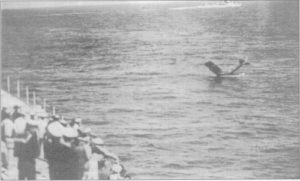
- Bad weather prevented us flying the Q.B. on the 12th, 13th, & 14th February, but the 1st Cruiser Squadron left harbour at 0630 on 15th Feb & this was the first day it was flown as a target. Australia’s second run was quite good & C.S.1 (RADM Max Horton ) congratulated us! The Q.B. was shot down in the close range shoot. We put up a second one which was apparently damaged by a near miss ( by Ajax) and crashed.
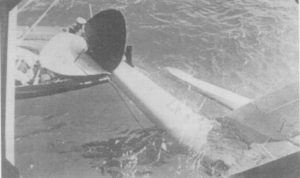
- To sea on the 18th Feb. Where the Q.B. survived shooting by the Battle Squadron, Coventry & Arethusa, but damaged a wing as we hoisted it inboard. We flew one on the 19th Feb, but low cloud spoilt the shooting & finally the Q.B. got out of control and crashed.
- Flew again on 25th of Feb. Shooting was poor and & finally the Q.B. ran away from us and landed 56 miles away safely (controlled by Fearless Fred!! see attached poem by TORO) & we re-embarked her undamaged.
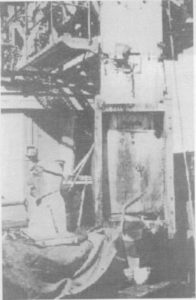
- Flew on 27th Feb; Q.B. landed undamaged & I took the cutter (32′ x 12 oared ) away to tow her back alongside. Flew on 3 March, landed undamaged & hoisted in. Flew on 5 March, Q.B. “old Fred” passed through all sorts of hellfire & then cracked up on landing.
- Flew on 10 March, Q.B. stayed up for about 15 runs & then crashed on landing. (multiple pom poms helped!!)
- Flew off for the last time on 12 March. “Daring Dan” went out of control after 8 runs & crashed.
The poem referred to in the diary was written by Lieut (E) J. W. N. (Johnny) Bull after the recovery of the runaway Queen Bee on the 26th of Feb 1936. Judging by the diary comments for 12th of March “Fearless Fred” may have been lost on one of his flights on or after the 5th of March and replaced by “Daring Dan”.
On 13 March, Australia received a fine signal from the Commander in Chief: “The willingness and promptitude with which Australia undertook the duties of Catapulting & controlling ship for the Queen Bee firings have been equalled by her efficiency in these duties.”
A total of 320 Queen Bees were built by de Havilland and 100 by Scottish Aviation near Glasgow. The last production aircraft was delivered in July 1944.
References:
- Scale Aircraft Modeling
- Midshipman’s Diary of Capt. W.F. Cook RAN (Ret)
- JANES all the worlds Aircraft 1936




